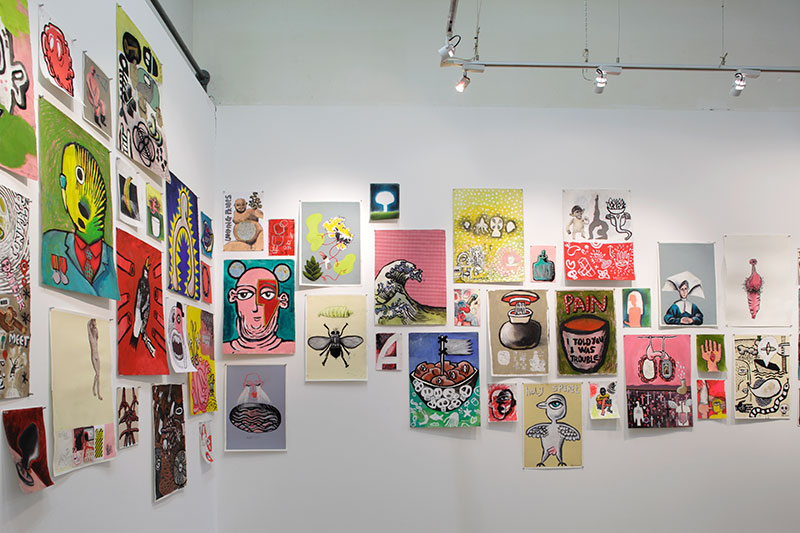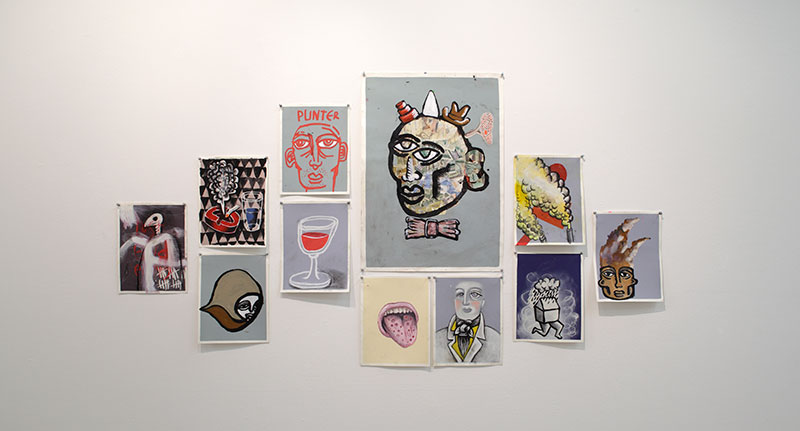
A sea of images confronts the viewer upon entering Darwin’s Northern Centre for Contemporary Art. The exhibition, Chronic Manageable Conditions, 2015–16, is an installation of works on paper by Darwin artist Andy Ewing. It includes drawing, painting and collage. Each sheet is arranged in an assemblage that appears random at first, slowly revealing a logic that is more organic. The works, rendered in a variety of sizes, are self-contained as an entity, while at the same time drawing upon the process of juxtaposition with others. This body of images is not about the preciousness of the discrete object, but rather the power of the multitude. To this end, the sheets of paper are not framed but pinned to the wall creating a more informal setting somewhat reminiscent of an artist’s studio. It is as if the viewer encounters a territory of images: a mapping of the inner psyche that reveals the jumble of concerns that characterise existence.
In some ways the project can be seen as a mantra to the Latin phrase carpe diem. Representing a year of productivity, there is a diaristic element to the series. Ewing worked each day, a process that demanded presence in the moment. After experiencing three years of chronic pain from pancreatitis, Ewing finally found relief allowing a freedom to work. But it was after encountering his brother in a coma, that Ewing was struck by the impermanence of life, an awakening that found expression in this visual abundance.
Looking closely at the array of imagery sprawled along the walls up and over the doorway, rich colours and bold graphic elements dominate. The depictions are largely figurative. Ewing was inspired by artists from Jogjakarta that he encountered when living in Indonesia and there is also a nod to Basquiat in many of the images. Ewing’s Catholic upbringing underpins a number of the works. Recurrent imagery pertaining to sexuality and Christian iconography are sprinkled throughout. Some of the images are more overtly homoerotic, cathartic in their release from the pressure to repress, while others consider the contradictions inherent in Christian morality.
A number of works reveal a preoccupation with the body and illness. In one small painting a figure covered in a rash reclines lethargic in bed. Other images incorporate various organs or reveal the interior workings of the body. In one work, cut-out illustrations from a medical text creates a substrata painted over in blood red, while another reconstructs a human skeleton from slices of musical notations. A couple of images depict disease on the surface, such as a body covered in spots or an ulcerated tongue. Cultural critic Susan Sontag describes illness as the “night-side of life”, a place of otherness where the physicality of the body dominates.[1] She notes that, at various times, certain illnesses have been associated with repression; particularly the suppression of true sexual nature, and that wellness was only possible with an acceptance of sexuality. Writer Thomas Mann believed that disease and death were inherent to the human condition and declares in the novel The Magic Mountain: “to be human is to be ill”. There is definitely an element of this in Ewing’s imagery.

Ewing describes his life as a hyphen – a space in between. His mother (who died when he was young) was from North Vietnam and his father was an officer in the RAAF. According to Ewing, it was “a marriage of enemies, with its own rich baggage”.[2] His Vietnamese heritage is explored through several works in the installation that draw upon media imagery of the Vietnam War. Growing up in Australia, he learnt about Vietnam through television and photographs in the newspapers. The Vietnam War was the first so-called “television war”. At a time before heavy media censorship, footage was relayed nightly into middle class living rooms around the world. Susan Sontag notes photography’s capacity to leech humanity from war imagery resulting in a failure of empathy.[3] Ewing reworks iconic images and through paint and collage alters our relationship to the photograph, installing an emotional tone to viewing the atrocities that took place.
There is an authenticity to this body of work that makes the imagery so compelling. Some of the images are more resolved and highly worked, while others resemble visual jottings. But all are endowed with an immediacy and energy. By combining humour, pathos and candour with a personal mythology, Ewing considers the “messiness” of subjectivity, embracing the multitudinous and often contradictory nature of influences that inform experience.

Footnotes

